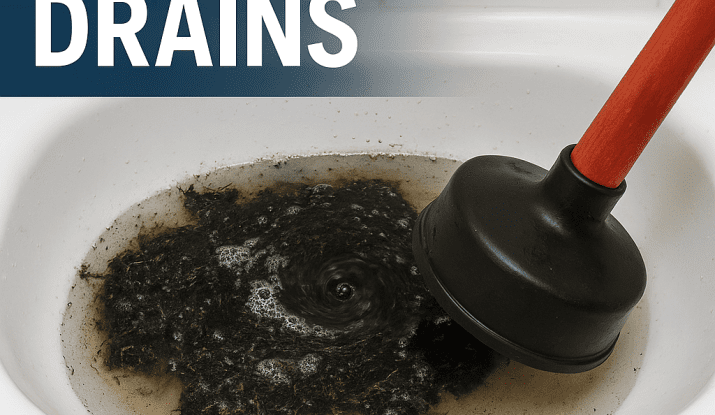Blocked drains are one of the most common plumbing issues that can disrupt daily life and lead to costly damage if ignored. Whether it’s a slow-draining sink or a completely clogged shower, knowing what to do before calling a professional can help you avoid unnecessary expenses and prevent bigger issues.
Let’s break down what causes blocked drains, how to identify the early warning signs, what you can try yourself, and when it’s time to contact a licensed plumber.
Common Signs of a Blocked Drain
Drain blockages rarely happen without warning. Recognising the early signs can save you from dealing with a major plumbing emergency. Keep an eye out for these symptoms:
- Water draining slowly in sinks, bathtubs, or showers
- Unusual gurgling sounds coming from drains or toilets
- Bad odours, especially near kitchen sinks
- Water pooling around floor drains
- Backflow or rising water levels in toilets when flushed
If you notice any of these issues, act quickly. Ignoring them can lead to pipe damage, mould growth, or even structural damage in extreme cases.
What Causes Blocked Drains?
Understanding the root cause is essential to finding the right solution. Here are the most common reasons behind drain blockages:
- Hair buildup: Most common in bathroom sinks and showers
- Grease and fat: Frequently found in kitchen sinks
- Food scraps: Even with garbage disposals, not all food waste breaks down
- Soap scum: Over time, it can harden and restrict water flow
- Tree roots: Especially in older homes with clay or porous pipes
- Toiletries: Wet wipes, cotton pads, and other non-flushable items
- Foreign objects: Children’s toys, jewellery, or other items accidentally flushed or dropped
What You Can Try Before Calling a Plumber
You don’t always need to pick up the phone right away. There are a few simple things you can do to clear minor blockages:
- Use a Plunger
The classic tool for a reason. A good plunge can dislodge blockages in toilets and sinks. Ensure a tight seal and try several firm pumps.
- Pour Boiling Water
Grease and soap build-up can sometimes be cleared with boiling water. This is best suited for kitchen sinks.
- Baking Soda and Vinegar
Mix half a cup of baking soda followed by one cup of white vinegar. Let it sit for 30 minutes before rinsing with hot water. This natural cleaner can help dissolve buildup without damaging pipes.
- Remove the Trap
In kitchen or bathroom sinks, you can manually remove the U-bend (trap) under the basin. Clean it out and flush it before reconnecting.
- Drain Snakes or Hand Augers
Available at hardware stores, these tools can reach deeper into the pipes to dislodge tougher blockages.
⚠️ Avoid using chemical drain cleaners. They may offer short-term relief but can corrode pipes, especially in older systems.
When Should You Call a Professional?
DIY solutions are useful, but they won’t solve every problem. Here’s when it’s time to bring in a licensed plumber:
- Recurring blockages even after clearing
- Multiple drains backing up simultaneously
- Foul odours that don’t go away
- Signs of water damage or mould near plumbing
- Overflowing toilets or complete pipe blockages
Professionals use advanced tools like CCTV drain cameras, high-pressure jetters, and pipe locators to identify and clear blockages effectively—saving time and reducing long-term costs.
How Plumbers Diagnose and Fix the Issue
If the blockage is beyond reach or caused by structural issues, a plumber will carry out a more thorough investigation. Some of the tools and techniques used include:
- CCTV Drain Inspections: Small cameras are fed into the pipeline to identify the blockage’s cause and location
- Hydro Jetting: A high-pressure stream of water clears even the most stubborn blockages
- Pipe Relining: For cracked or broken pipes, relining is a trenchless solution to restore functionality without digging
- Root Cutting Equipment: Specifically designed to remove tree roots from sewer lines
These methods are quick, precise, and prevent further damage to your plumbing system.
Prevention Tips: How to Avoid Future Blockages
Taking a few preventative steps can keep your drainage system healthy and save you from unexpected repair costs:
- Avoid pouring grease or oil down the sink
- Install hair catchers in bathroom drains
- Only flush toilet paper – avoid wet wipes and sanitary items
- Schedule routine plumbing inspections, especially for older properties
- Educate household members on what not to put down the drain
By developing good habits, you can minimise your risk and extend the lifespan of your plumbing.
Blocked drains can escalate from a minor annoyance to a serious issue if not addressed promptly. While DIY solutions may work for simple cases, knowing when to call a plumber is crucial. Reliable plumbing services are essential for long-term protection and peace of mind.
If you’re located in Australia and dealing with persistent drainage problems, it’s best to consult a licensed expert. A professional can offer long-term solutions that go beyond temporary fixes.
By understanding what causes blocked drains and how to respond, you can stay ahead of the problem—and keep your home running smoothly.


